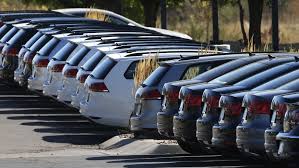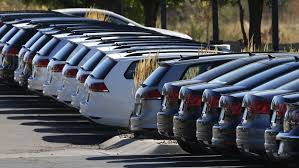
While stopping short of asking for a specific reduction in the requirements for 2025, troubled by the costs that would be onerous and the standards would not reflect how cheap gas prices are affecting consumer demand, automaker trade groups told U.S. regulators they should revise fuel efficiency mandates approved in the final weeks of the Obama administration.
In a battle between automakers and the state of California and environmental groups, which argue against any retreat from limits to greenhouse gas emissions, the comments to the Environmental Protection Agency (EPA) and the National Highway Traffic Safety Administration (NHTSA) set up the next round.
Including flexibility in the use of a system of credits under the program, automakers want changes that would make it easier for them to comply with fuel economy standards.
Overseen by the NHTSA and vehicle emissions limits regulated by the EPA, automakers have to meet parallel fuel economy standards.
Saying it is needed to promote economic growth, President Donald Trump has championed deregulation. In March he told auto workers, “We are going to ensure that any regulations we have protect and defend your jobs, your factories.”
The EPA understated the costs of technologies needed to meet the 2025 requirements, said the Alliance of Automobile Manufacturers, a trade group representing General Motors Co, Toyota Motor Corp, Volkswagen AG and others.
The EPA revised the fleetwide average fuel economy to 51.4 mpg based on a rising number of trucks after the Obama administration finalized rules in 2012 to double it to 54.5 mpg by 2025. Because of credits automakers receive and differences in test procedures versus real-world driving, the EPA said that would result in a real world average of 36 mpg by 2025.
Automakers can then apply credits to deficits in future years and they earn credits by producing cars and trucks that exceed the requirements in a given year. Building electric vehicles and other improvements that may not be captured in testing procedures, they also earn credits for air conditioning improvements.
errors in modeling the impact of new technology and assumptions about fuel prices and sales trends that have proved wrong formed the basis of the Obama administration finding that the 2025 targets were achievable at reasonable cost, automakers said.
Shifting consumer preferences for bigger vehicles as a problem was cited by Global Automakers, a group representing Honda Motor Co, Hyundai Motor Co and others.
“There is, simply put, a misalignment between the increasing stringency of the standards and the decreasing consumer demand for fuel efficiency,” the group said in comments filed late Thursday with the EPA.
After they said a prior model “caused the agencies to overestimate the role that conventional technologies can play in achieving future” improvements, the two auto groups said the EPA has agreed to develop a new modeling approach.
If the current standards are weakened, California, the most populous U.S. state, will withdraw from a 2012 agreement to adhere to the national EPA standard, and this is the risk for automakers. A dozen other states follow the standards of California. In order to avoid higher costs by having to meet two differing standards, it is vital to maintain one national regime for emissions regulation, automakers have said.
(source:www.reuter.com)
In a battle between automakers and the state of California and environmental groups, which argue against any retreat from limits to greenhouse gas emissions, the comments to the Environmental Protection Agency (EPA) and the National Highway Traffic Safety Administration (NHTSA) set up the next round.
Including flexibility in the use of a system of credits under the program, automakers want changes that would make it easier for them to comply with fuel economy standards.
Overseen by the NHTSA and vehicle emissions limits regulated by the EPA, automakers have to meet parallel fuel economy standards.
Saying it is needed to promote economic growth, President Donald Trump has championed deregulation. In March he told auto workers, “We are going to ensure that any regulations we have protect and defend your jobs, your factories.”
The EPA understated the costs of technologies needed to meet the 2025 requirements, said the Alliance of Automobile Manufacturers, a trade group representing General Motors Co, Toyota Motor Corp, Volkswagen AG and others.
The EPA revised the fleetwide average fuel economy to 51.4 mpg based on a rising number of trucks after the Obama administration finalized rules in 2012 to double it to 54.5 mpg by 2025. Because of credits automakers receive and differences in test procedures versus real-world driving, the EPA said that would result in a real world average of 36 mpg by 2025.
Automakers can then apply credits to deficits in future years and they earn credits by producing cars and trucks that exceed the requirements in a given year. Building electric vehicles and other improvements that may not be captured in testing procedures, they also earn credits for air conditioning improvements.
errors in modeling the impact of new technology and assumptions about fuel prices and sales trends that have proved wrong formed the basis of the Obama administration finding that the 2025 targets were achievable at reasonable cost, automakers said.
Shifting consumer preferences for bigger vehicles as a problem was cited by Global Automakers, a group representing Honda Motor Co, Hyundai Motor Co and others.
“There is, simply put, a misalignment between the increasing stringency of the standards and the decreasing consumer demand for fuel efficiency,” the group said in comments filed late Thursday with the EPA.
After they said a prior model “caused the agencies to overestimate the role that conventional technologies can play in achieving future” improvements, the two auto groups said the EPA has agreed to develop a new modeling approach.
If the current standards are weakened, California, the most populous U.S. state, will withdraw from a 2012 agreement to adhere to the national EPA standard, and this is the risk for automakers. A dozen other states follow the standards of California. In order to avoid higher costs by having to meet two differing standards, it is vital to maintain one national regime for emissions regulation, automakers have said.
(source:www.reuter.com)














